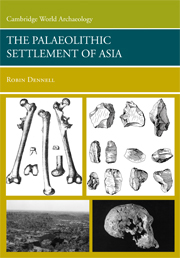Book contents
- Frontmatter
- Contents
- List of Tables, Figures, and Boxes
- Preface
- 1 Asia and Its Place in Palaeoanthropology
- 2 The African Background to the Colonisation of Asia
- 3 The Climatic and Environmental Background to Hominin Settlement in Asia before 1 MA
- 4 The Earliest Inhabitants of Southwest Asia
- 5 The Earliest Inhabitants of South and Southeast Asia and China
- 6 “Out of Africa 1” Reconsidered and the Earliest Colonisation of Asia
- 7 The Climatic and Environmental Background to Hominin Settlement in Asia between ca. 1 Ma and the Last Interglacial
- 8 The Middle Pleistocene Archaeological Record for Southwest and Central Asia
- 9 The Middle Pleistocene Archaeological Record of the Indian Subcontinent
- 10 The Middle Pleistocene Archaeological Record of China and Southeast Asia
- 11 Human Evolution in Asia during the Middle Pleistocene
- 12 Concluding Remarks
- Appendix 1 The Sizes of Countries and Regions in Asia, with Comparative Examples
- Appendix 2 Geographical Coordinates of Principal Early Palaeolithic Sites in Asia
- Appendix 3 Geographical Coordinates of Geological Sections and Cores
- Appendix 4 English Names of Various Mammals Recorded in Asia
- Bibliography
- Index
9 - The Middle Pleistocene Archaeological Record of the Indian Subcontinent
Published online by Cambridge University Press: 05 June 2012
- Frontmatter
- Contents
- List of Tables, Figures, and Boxes
- Preface
- 1 Asia and Its Place in Palaeoanthropology
- 2 The African Background to the Colonisation of Asia
- 3 The Climatic and Environmental Background to Hominin Settlement in Asia before 1 MA
- 4 The Earliest Inhabitants of Southwest Asia
- 5 The Earliest Inhabitants of South and Southeast Asia and China
- 6 “Out of Africa 1” Reconsidered and the Earliest Colonisation of Asia
- 7 The Climatic and Environmental Background to Hominin Settlement in Asia between ca. 1 Ma and the Last Interglacial
- 8 The Middle Pleistocene Archaeological Record for Southwest and Central Asia
- 9 The Middle Pleistocene Archaeological Record of the Indian Subcontinent
- 10 The Middle Pleistocene Archaeological Record of China and Southeast Asia
- 11 Human Evolution in Asia during the Middle Pleistocene
- 12 Concluding Remarks
- Appendix 1 The Sizes of Countries and Regions in Asia, with Comparative Examples
- Appendix 2 Geographical Coordinates of Principal Early Palaeolithic Sites in Asia
- Appendix 3 Geographical Coordinates of Geological Sections and Cores
- Appendix 4 English Names of Various Mammals Recorded in Asia
- Bibliography
- Index
Summary
INTRODUCTION
The Middle Pleistocene record for hominins in India is potentially one of the best in the Old World. It has been investigated for almost as long as in western Europe, and far longer than in Africa; numerous sites have been excavated, often to a high standard; and there are some excellent studies of Early Palaeolithic landscapes, most notably in the Hunsgi-Baichbal valley systems of southern India. Additionally, India has a rich ethnographic record of modern hunter-gatherers that has enriched assessments of plant usage, hunting techniques, patterns of land use, and material culture (see, for example, Paddayya 1982; Pappu 2001a; Raju 1988). Because of its size and location, India is also critical to understanding whatever dispersals of populations and techniques occurred between East Africa and the Levant to its west, and China and Southeast Asia to its east.
There are various reasons that India has not figured prominently in general discussions of the Early Palaeolithic or human evolution. One is that faunal material is only exceptionally preserved in Indian Middle Pleistocene sites, and even when present, rarely comprises more than a few isolated and poorly preserved teeth. The fossil hominin record of India is also limited to just a poorly dated hominin calotte and clavicle from the Narmada valley (see Chapter 11). Another weakness is that Early Palaeolithic sites in India have proved difficult to date, and the shortage of reliable absolute dates (or more accurately, the shortage of materials and deposits that can be dated absolutely) means that the chronological framework for the Indian Early Palaeolithic (see Table 9.1) still needs considerable development before it reaches the same standard as those for the Levant or western Europe.
- Type
- Chapter
- Information
- The Palaeolithic Settlement of Asia , pp. 336 - 395Publisher: Cambridge University PressPrint publication year: 2008

